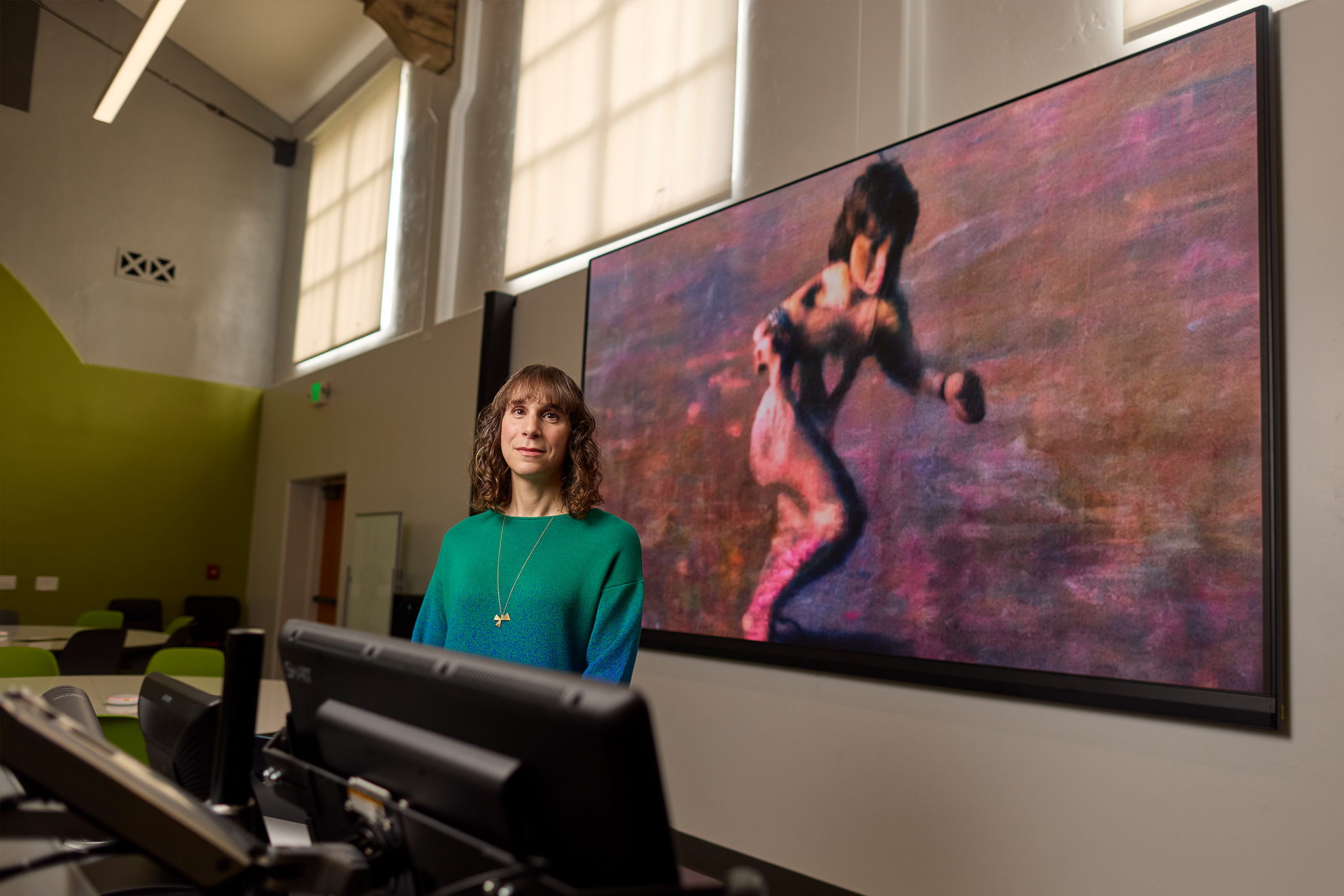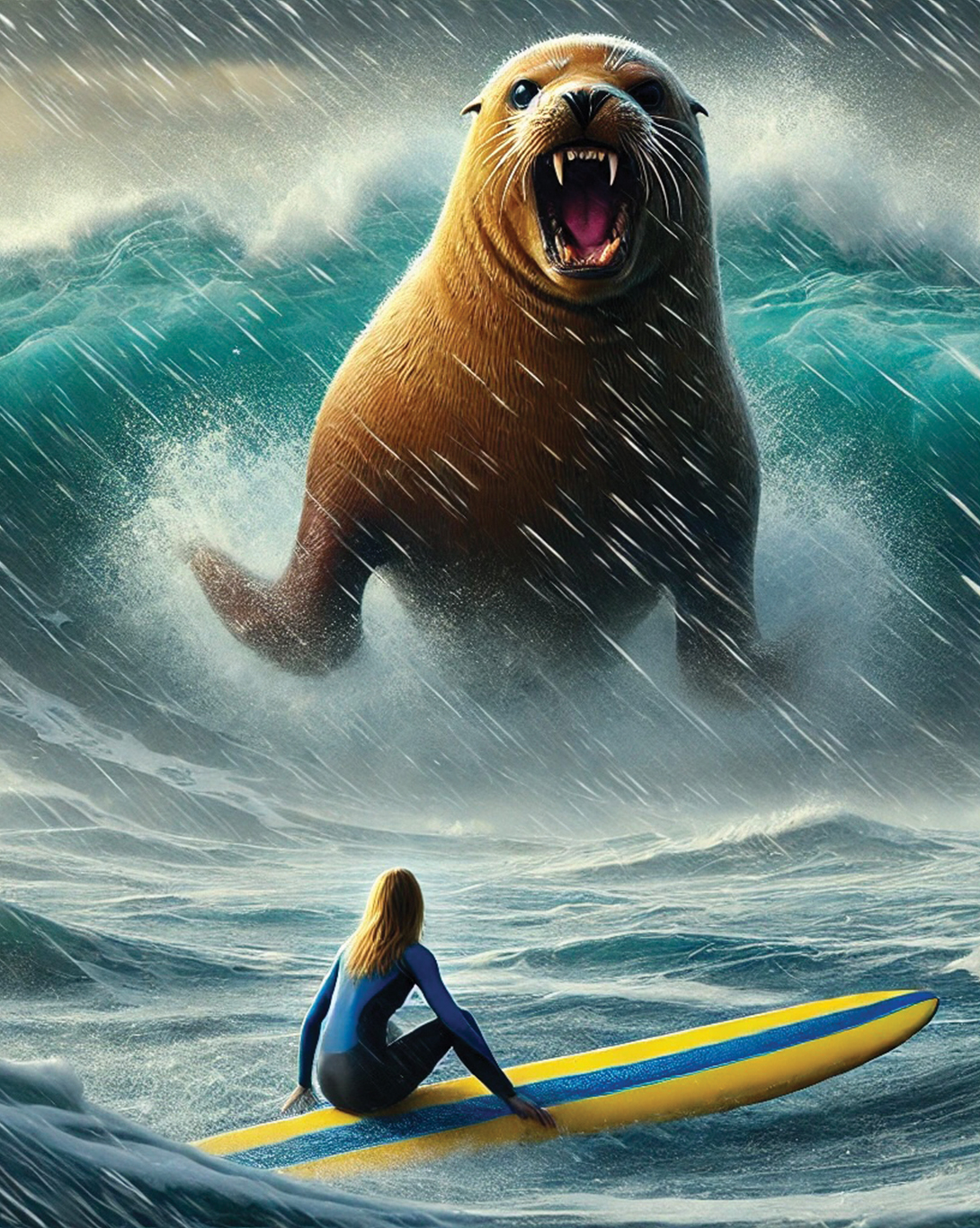The Intersection of Art and AI

Is generative AI friend or foe? That’s a question professors and students are facing in SDSU’s School of Art and Design—and the answer isn’t always black and white.
By Michael Klitzing
IN DECEMBER, STEPHANIE WISE was out on her board as she’d been countless times before. This time wouldn’t be like the others.
The avid surfer and San Diego State University multimedia major paddled into the Pacific alongside her father at a secluded spot near Marina del Rey Harbor outside of Los Angeles. She soon found they had company—a very large, very territorial sea lion.
Wise didn’t see the animal until it was practically on top of her.
“It breached over me and blocked the sun out of view, fully out of the water,” Wise says. “It looked into my soul and it growled at me in a monstrous terrifying way I could never forget. It was awful.”
Wise was unharmed but returned to shore shaken and exhausted.
Her father, whose back had been turned during the frightening encounter, insisted she was overreacting. Ever the artist, Wise decided she had to make him see it to believe it when she got home. Typing detailed prompts into a generative pre-trained transformer (GPT) image generator, she produced a series of images of a demonic beast—all fangs and claws—bearing down on a self-portrayal, frozen in terror.

“It would have taken me hours to draw that situation,” Wise says. “In that moment, when I was so exhausted and it was so fresh on my brain, I wanted those visuals to come out immediately. My dad changed his tune when he saw the images.”
As the wave of ever-advancing generative AI sweeps over academia, debate rages about the fantastical opportunities and existential threats presented by this technology. And the uncertainty of the moment is felt deeply in the art world.
Some see a powerful new tool in the artist’s toolbox—one that opens up new possibilities for creative expression. Others see danger lurking beneath the surface, threatening the creative process.
One can find adherents of both viewpoints in the SDSU School of Art and Design, which cultivates promising artists looking to push creative boundaries in media ranging from the tactile—think paint, clay, metal and wood—to the digital.

“We’re all trying to adjust to something that’s happening very quickly and changing very rapidly,” says Ava Aviva Avnisan, assistant professor of integrated design. “There are a lot of questions. What does this mean for teaching? How do you allow, or not allow, students to use these tools? How do we prepare students for that future in their fields?
“It doesn’t ever feel like there’s enough time to be having these conversations.”
AT THE INSTITUTIONAL LEVEL, SDSU has largely embraced the use of generative AI within ethical guardrails. The university’s Information Technology Division offers resources and training for faculty and staff, including an Academic Applications of AI Micro-Credential launched last summer. In March, the California State University launched a program with OpenAI’s ChatGPT Edu, an AI-powered assistant tailored for academic and research environments that’s free to faculty, staff and students.
James Frazee, SDSU’s vice president for the Information Technology Division and chief information officer, says that generative AI presents an opportunity to push the boundaries of creativity and rethink how the SDSU community engages with technology in the creative process.
“We’re preparing our students to be at the forefront of a rapidly evolving digital landscape,” Frazee says, “and we’re committed to fostering responsible, ethical and critical engagement with AI, ensuring that our community doesn’t just use these tools but also understands their implications and leads in shaping their future applications.”
Avnisan is something of an early adopter. As a tech-savvy new media artist specializing in performance, photographic and interactive installations and film/video, she’s begun using AI in her own work. Her film essay “Specters of Home—Prologue” explores the connections between her own Arab-Jewish family’s exodus from Iraq and Iran and the 1948 displacement of Palestinians; it also makes extensive use of generative AI animations. She and collaborator Doug Rosman, assistant professor at the School of the Art Institute of Chicago, fed 8mm footage from Avnisan’s childhood in Jerusalem to the AI engine one frame at a time to create a unique style of AI-generated animation.
“When I first saw these images, I was like, ‘There’s something there that is so strange and so haunting,’” Avnisan says.

In the past year, Avnisan has started inviting students to engage with generative AI as a “collaborator” to complete assignments in her creative coding class. But she does so in a structured way. For instance, rather than having students prompt ChatGPT to create a specific visual design, she will ask them to think about the architecture of a script first, do the planning and then ask AI to create sections within their plan.
One of Avnisan’s most enthusiastic students is Wise. Born and raised in Venice Beach, Wise is interested in pursuing a career in 3D art or marketing. She is deeply immersed in the action sports culture, and her art includes airbrushing designs on surfboards. Lately she’s been tinkering with robotics and virtual reality.
“I am an artist, and I do believe in the craft,” Wise says. “But now that we’re moving forward into this new realm of having generative AI accessible to us, I think it’s really cool to experiment with it. Now I feel like I’m approaching artwork in a scientific way.”
MATTHEW HEBERT is hardly an enemy of technology. The professor of furniture design and woodworking teaches courses in digital fabrication and 3D modeling. This semester, he’s teaching embedded computing for artists and designers. When it comes to generative AI and its implications for artistic expression, however, he’s concerned about its potential to stifle creativity and innovative thinking.
“I feel like it’s taking the most interesting part of the process and handing it over to a computer,” Hebert says. “You try to get students excited about ideation and conceptualization of a design, thinking about it from their own lived experience or idiosyncrasies. Now they can just take the prompt and feed it into a computer that is going to pull off everybody’s experiences.”
Hebert, who works under the studio name “eleet warez,” explains that his own process with 3D media requires coming up with an idea, reflecting on it and improving on it in multiple iterations. But what happens when generative AI makes your first iteration convincingly good enough?
“You’re just going to be happy with the idea, right?” Hebert says. “It’s sort of easy. It’s given to you. And now you’re just going to sort of march forward and try to make it a reality. To me, as an artist, that’s a pretty sad way to go through the process.”
What’s striking in talking to both skeptics and early adopters of generative AI is how much shared apprehension exists about what lurks beneath the surface. Avnisan admits to harboring concerns that generative AI may one day make her replaceable as an educator.
But she also knows that AI is not going away. Her charge, as she sees it, is to get students to use the technology ethically—and in a way that augments artistic expression rather than smothers it.
“The way I see my challenge as an educator is to create a class in which I can convince students that there’s a right time and place and a wrong time and place to use these tools,” Avnisan says. “How do we get them to want to not take the shortcut when the shortcut’s available?
“That’s a hard challenge as an educator—but it’s also kind of an exciting challenge.”
For Wise’s part, she isn’t afraid of the unknown. She insists the freedom to interface with generative AI has fueled her inspiration and curiosity.
“Now that the technology is learning on its own, and I can collaborate with it and even boost my own educational level with it, I feel like I’m able to do a lot more,” she says.
“It’s making me a superhuman without putting a computer chip in my brain—it’s just on my phone.”
